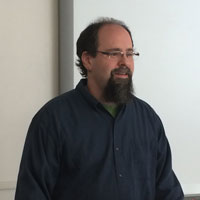
Teaching Religion and Prophetic Activism
Over the past several weeks, we have seen over and over again violence against people, mostly women of color, presumed to be Muslim. The attackers have been white men who targeted their victims based on the victim’s presumed religion. Some of the increase in these hate crimes can be attributed to a rise in anti-Muslim rhetoric from political leaders which emboldens those with xenophobic views to be more public. However, the lack of a large public outcry against such crimes comes from long held racist assumptions rooted in Orientalism about Muslims which are reinforced by the media, popular culture, government narratives, and, too often, by some non-Muslim religious narratives. The question for any religious studies teacher in these times has to be: what can I do to help counter these assumptions, attitudes, and false narratives? Taking such a question seriously is not without risk, but teaching about religion is not a politically neutral endeavor. Talking about religion, teaching about religion, is political.
My entire teaching career has been motivated by how narratives create our reality. This is not something new. After all, bell hooks, Edward Said, Stuart Hall, Paul Ricoeur, Judith Plaskow, Dwight Hopkins, Sheila Davaney, and many, many others have pressed for decades about representation and the creation of narratives. However, in our current cultural and political climate I often find myself pausing to consider the narrative, or better, the counter-narrative that needs to be told. Our assumptions about other people are shaped by the information we possess. In many instances, the information we possess is limited at best and ill-informed at worst. This understanding informs how I think about teaching religion.
When teaching my “Introduction to Religious Studies” classes I have two goals in mind. First, I want to raise the students’ awareness of the relationships between religion and politics. Religious language is used to justify violence by non-state groups who claim religious identities. Religious language is also used to justify laws and policies about abortion, the death penalty, military strikes, violence, human rights, women’s rights, LBGTQ rights, etc., etc. Second, I hope to raise the level of students’ religious literacy. If our assumptions about other people are shaped by our knowledge, then introducing students to the commonly held beliefs and narratives of various religious communities should result in students having a better understanding about others.
When I teach religious studies courses I use a human centered approach. As often as possible, I try to expose students to different practitioners within and among religious traditions. The challenge is always finding the balance between giving students general information about religious beliefs without generalizing and essentializing an entire tradition based on the beliefs of individual practitioners. The larger point is to humanize religious beliefs and practices. When students hear the stories of others, students find ways to connect with folks on a human level. Making a human connection then allows for a different kind of conversation about the interplay between religion and politics. The stereotypes and ill-informed assumptions start to be replaced by new knowledge.
As students begin to think differently about human beings and the practices of religion, they also begin to ask critical questions. One of the questions students often ask is about the media’s and popular culture’s engagement with religion. Many students notice that religion is mostly presented as conservative, damaging, and/or violent with very little attention given to religious people who are working to create positive social change rooted in justice. It is during these moments that I am able to introduce to students groups and individuals who might be labeled “prophetic activists.” The idea of prophetic activism is as old as religion itself, but the term as I am using it comes from Helene Slessarev-Jamir. Slessarey-Jamir defines prophetic activism as “religion [that] is being used to frame progressive politics that prophetically calls for justice, peace, and the healing of the world.”[1] Some of the groups I tend to introduce in class include: Jewish Voices for Peace, SpiritHouse Project, Christian Peacemaker Teams, Muslim Advocates, and Four Winds American Indian Council. For example, Jewish Voices for Peace has consistently spoken out against anti-Muslim hate, be it a Chanukah ceremony to overcome racism and Islamaphobia or showing up at airport protest against the “Muslim Travel Ban.” It is prophetic activist groups such as Jewish Voices for Peace that help provide a counter-narrative of justice and nonviolent social change rooted in religion.
I started out asking how religious studies teachers can help counter the racist and xenophobic assumptions, attitudes, and narratives that lead to violence and/or silence. My suggestions include a human-centered approach to teaching religion, to make the connections between religion and politics overt, and to provide counter-narratives that are rooted in justice and nonviolent social change. Most importantly, I think it is up to those of us who teach about religion to provide opportunities to change, confront assumptions, and to call out violence done in the name of religion or because of religion.
[1] Helene Slessarev-Jamir, Prophetic Activism: Progressive Religious Justice Movements in Contemporary America (New York: New York University Press, 2011), 4.
Leave a Reply